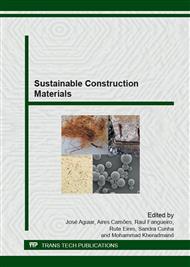[1]
C.A.M. Moraes, A.G. Kieling, M.O. Caetano, L.P. Gomes, Life cycle analysis (LCA) for the incorporation of rice husk ash in mortar coating, Res. Conserv. Recycl. 54 (2010) 1170–1176.
DOI: 10.1016/j.resconrec.2010.03.012
Google Scholar
[2]
P. K Mehta, Reducing the environment impact of concrete, Concr. Int. 23 (2001) 61-66.
Google Scholar
[3]
K.M. Lee, J.M. Park, Estimation of the environmental credit for the recycling of granulated blast furnace slag based on LCA, Res. Conserv. Recycl. 44 (2005) 139–151.
DOI: 10.1016/j.resconrec.2004.11.004
Google Scholar
[4]
P. Chindaprasirt, S. Rukzon, Strength, porosity and corrosion resistance of ternary blend Portland cement, rice husk ash and fly ash mortar, Constr. Build. Mat. 22 (2008) 1601-1606.
DOI: 10.1016/j.conbuildmat.2007.06.010
Google Scholar
[5]
AG Kieling, Influence of segregation in the performance of rice husk ash as pozzolans and adsorbing material, MSc thesis, UNISINOS, Rio Grande do Sul, Brazil (2009) 130p. [In Portuguese. ].
Google Scholar
[6]
V.P. Della, I. Kuhn, D. Hotza, Recycling of agroindustrial waste: Rice husk ash as an alternative silica source, Cerâm. Ind. 10 (2005) 22-25. [In Portuguese. ].
Google Scholar
[7]
Information on ftp: /ftp. ibge. gov. br/Producao_Agricola/Levantamento_Sistematico_da_Producao_Agricola_[mensal]/Fasciculo/lspa_201311. pdf.
Google Scholar
[8]
R.V. Krishnarao, J. Subrahmanyam, T.J. Kumar, Studies on the formations of black particles in rice husk silica ash, J. Eur. Ceram. Soc. 21 (2001) 99-104.
DOI: 10.1016/s0955-2219(00)00170-9
Google Scholar
[9]
J.H. S Rego, Technical viability of the use of rice husk ash produced with no temperature control as admixture to cement, MSc Dissertation, UFG, Brazil, 2001. [In Portuguese. ].
Google Scholar
[10]
P.K. Mehta, P.J.M. Monteiro, Concrete: structure, properties and materials, Ed. Pini, São Paulo, Brasil, 1994. [In Portuguese. ].
Google Scholar
[11]
J.C. Rocha, M. Cheriaf, Reuse of waste in the building industry, in: J.C. Rocha, V.M. Jonh (Eds. ), Use of waste in the construction of accommodation, Volume 4, ANTAC, Porto Alegre, 2003, pp.72-93.
Google Scholar
[12]
S. Santos, Viability study of the use of rice husk ash in mortars and concrete, MSc thesis, UFSC (1997). [In Portuguese. ].
Google Scholar
[13]
V.M. Jonh, S.C. Ângulo, Methodology to develop waste recycling, in: J.C. Rocha, V.M. Jonh (Eds. ) Coletânea Habitare, Use of waste in the construction of accommodation, Volume 4, ANTAC, Porto Alegre, 2003, pp.8-71.
Google Scholar
[14]
ASSOCIAÇÃO BRASILEIRA DE FUNDIÇÃO. CEMP (Comissão de Estudos de Matérias Primas) n° 120: Materiais para Fundição – Determinação da Perda ao Fogo, (2003).
Google Scholar
[15]
ASSOCIAÇÃO BRASILEIRA DE NORMAS TÉCNICAS. NBR 5752. Materiais Pozolânicos – Determinação da atividade pozolânica com o cimento – Índice de atividade pozolânica. Rio de Janeiro, (1992).
DOI: 10.1590/s1517-707620170003.0207
Google Scholar
[16]
ASSOCIAÇÃO BRASILEIRA DE NORMAS TÉCNICAS. NBR NM 248 – Agregados – Determinação da composição Granulométrica. Rio de Janeiro, (2003).
Google Scholar
[17]
ASSOCIAÇÃO BRASILEIRA DE NORMAS TÉCNICAS. 2005. NBR 7211 – Agregados para concreto - Especificação. São Paulo, (2005).
Google Scholar
[18]
M.P. Luxàn, Rapid evaluation of pozzolanic activity of natural products by conductivity measurement, Cem. Concr. Res. 19 (1989) 63-68.
Google Scholar
[19]
M.T.F. Pouey, Use of rice husk ash to produce blended and/or pozzolanic cement, PhD thesis, UFRGS, Brazil, 2006. [In Portuguese. ].
Google Scholar
[20]
M.M. Tashima, Highly reactive rice husk ash: a method of production, physicochemical characterization and assessing behavior in Portland cement, PhD thesis, UNESP, São Paulo, 2006. [In Portuguese. ].
Google Scholar
[21]
R. Jauberthie, F. Rendel, S. Tamba, I. Cisse, Origin of the Pozzolanic Effect of Rice Husks, Const. Build. Mat. 14 (2000) 419-423.
DOI: 10.1016/s0950-0618(00)00045-3
Google Scholar
[22]
N.P. Hasparik, Investigation of the reaction mechanisms alkali-admixture – the effect of rice husk ash and active silica, MSc thesis, UFG, Brazil, 1999. [In Portuguese. ].
Google Scholar
[23]
C.S. Rodrigues, Effect of rice husk ash on the behavior of blended cements reinforced with bamboo pulp, PhD thesis, PUC, Rio de Janeiro, Brazil, 2004. [In Portuguese. ].
Google Scholar
[24]
R. Tiboni, The use of rice husk ash from a thermoelectric power plant as a component of the agglomerant of blended Portland cements, MSc thesis, Universidade de São Paulo, São Carlos, Brazil, 2007. [In Portuguese. ].
Google Scholar
[25]
J.R. Prudêncio, S. Santos, D.A. Dafico, Rice Husk Ash, in: J.C. Rocha, V.M. Jonh (Eds. ), Use of waste in the construction of accommodation, Volume 4, ANTAC, Porto Alegre, 2003, pp.240-261.
Google Scholar


